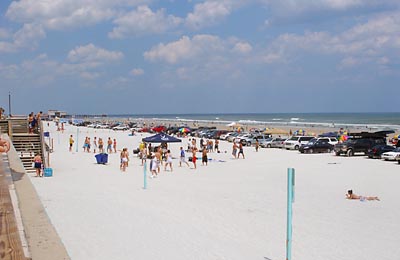Metal Detecting
Metal Detecting is just about the only way to find Gold in Florida. Silver, Platinum, Palladium, Lead, Titanium, Tungsten Carbide, Stainless Steel, Iron, Copper, and Aluminum also for that matter. Anyone that ever tried metal detecting is familiar with the Iron, Copper and Aluminum metals. Finding the other ones though is a bit more challenging, and time consuming.
Typical day at Daytona Beach.
Metal Detecting Beaches
A part of the Gold Prospecting Association of America is Treasure Hunting, and one way to do that is by Metal Detecting. Many places in America are land locked or have few areas where the ocean plays such an important role as it does here in Florida. Florida's Beaches for the most part are pristine sandy shorelines where people utilize them for all types of outdoor activities. Swimming, Surfing, Fishing, Biking, Hiking to name a few. Where ever people gather there is the potential for items to go missing. Some of them may be lost forever, while others are found pretty fast. Those made of metal can be located with the use of metal detectors.Florida also has a rich history of ships being lost at sea ever since America was discovered. Mel Fisher discovered the most famous one, the Nuestra Seora de Atocha. Mel Fisher Maritime Museum in Key West and Mel Fisher's Treasures Museum in Sebastian displays much of the items recovered.
Quite possibly the most famous set of shipwrecks is that of the 1715 Spanish Plate Fleet which sank during a hurricane. Several of the wrecks have been discovered over the years, but several are still waiting to be found. Just south of Sebastian Inlet is the McLarty Treasure Museum. This museum is part of the Florida State Park System and resides on the site of 1715 Spanish Plate Fleet Survivors and Salvaging Camp just feet away from the Atlantic Ocean. This site was discovered by Kip Wagner in the mid 1950's. Visitors are treated to artifacts found on site and from the nearby wreck of the El Capitana. A unique feature here is a log book dedicated to artifacts recently found on Florida's east coast treasure beaches by everyday people suchs as yourself.
Beaches are ever changing as storms, waves and tides adjust the shoreline day by day. Sands shift, shells and debris are deposited in patterns. These patterns can be viewed at low tides, and near these the ocean will also deposit heavier man made materials. Newly lost items can be found fairly pretty much where they were lost if the action of the ocean remains calm. Those lost in deeper water will remain there until storm waves transport them ashore.
For these reasons metal detecting beaches is a good place and well worth it. Several of the chapter members go out metal detecting, and we try to head out as a club at least once a year. Normal everyday items such as Coins, Flip Tops, Bottle Caps are routinely found, but one out of a hundred or so items, (maybe less, maybe more), will be a piece of jewelry. Will it be made of Gold or another precious metal is another story altogether.
Tips
1. Follow all local rules, regulations and fill in your holes.2. Head to beaches where people go to the most.
3. Detect the areas on the beach people use the most.
4. Pay attention to places the ocean recently changed the shoreline.
5. Use a quality detector with auto tracking if you like to detect from dry sand into wet areas. Otherwise balance your detector for a specific area, and rebalance as the conditions changes.
6. Large coils will allow a greater area to be covered with one swing.
7. Keep the coil low and swing slow.
8. Pay attention to what you're finding. A nice mix of items and coins lets you know the area wasn't searched recently, while 30 pennies in a row is telling you that someone was there recently and decided not to dig any of them.
9. Dig everything, except maybe Iron, but dig the iron as it may be masking out another more valuable item nearby.
10. Better items made out of Gold and Silver can be found anywhere on a beach, but up high and dry the trash will fly. Plan on digging loads of aluminum in the high and dry areas of a beach.
11. Don't discriminate out aluminum as many gold rings will then be discriminated out also. Gold is alloyed with many metals and some of which will be seen by detectors virtually the same as aluminum.
12. Practice... If your new to this hobby, make a test bed full of items at your house, and learn how your machine reacts to them. A coin on the surface versus the same coin at 2, 4, 6, 8, 10, 12 inches deep.
13. Take a gold ring, tie a string on it, and bury it at the beach at various depths. How far can you detect it? Try this again with other rings or a gold chain, or earrings... :). The results most likely will surprise you.
Additional Info.
If looking through our chapters pages has sparked an interest in the hobby, I'd suggest taking a look at Smarter Hobby's Metal Detecting Guide.Some of our chapter members are affiliated with one or more of the following metal detecting clubs.
Central Florida Metal Detecting Club, Debary/Sanford, Fl.
Dig and Find Metal Detecting Club, Daytona Beach, Fl.
Gold Coast Treasure Club, Inc., Jupiter, Fl.
Historical Recovery Association of North Florida, Jacksonville, Fl.
Treasure Coast Archeological Society, Sebastian, Fl.
West State Archaeological Society, Inc., Tampa, Fl.
Dig and Find Metal Detecting Club, Daytona Beach, Fl.
Gold Coast Treasure Club, Inc., Jupiter, Fl.
Historical Recovery Association of North Florida, Jacksonville, Fl.
Treasure Coast Archeological Society, Sebastian, Fl.
West State Archaeological Society, Inc., Tampa, Fl.
Also KellyCo Detectors is a generous sponsor for our events, and our chapter does support them whenever we are able to.
